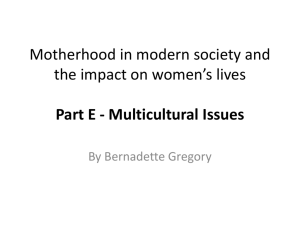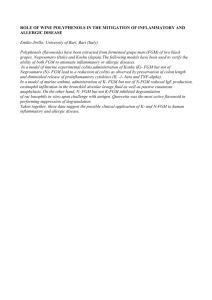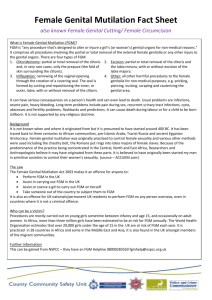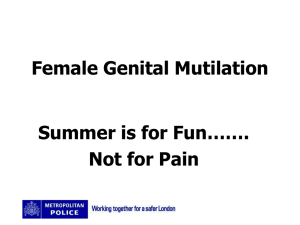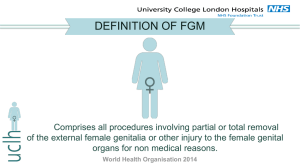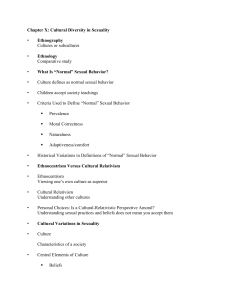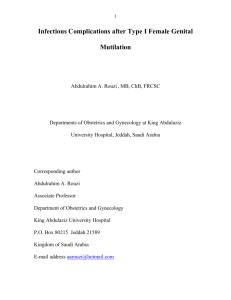Document 14164080
advertisement
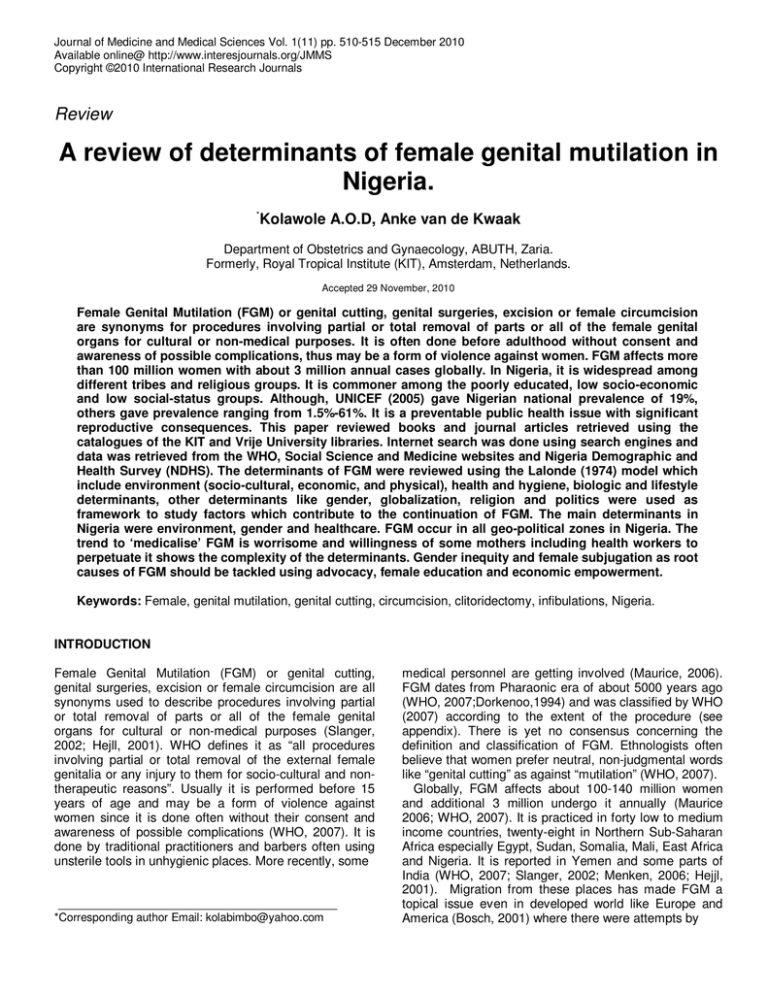
Journal of Medicine and Medical Sciences Vol. 1(11) pp. 510-515 December 2010 Available online@ http://www.interesjournals.org/JMMS Copyright ©2010 International Research Journals Review A review of determinants of female genital mutilation in Nigeria. * Kolawole A.O.D, Anke van de Kwaak Department of Obstetrics and Gynaecology, ABUTH, Zaria. Formerly, Royal Tropical Institute (KIT), Amsterdam, Netherlands. Accepted 29 November, 2010 Female Genital Mutilation (FGM) or genital cutting, genital surgeries, excision or female circumcision are synonyms for procedures involving partial or total removal of parts or all of the female genital organs for cultural or non-medical purposes. It is often done before adulthood without consent and awareness of possible complications, thus may be a form of violence against women. FGM affects more than 100 million women with about 3 million annual cases globally. In Nigeria, it is widespread among different tribes and religious groups. It is commoner among the poorly educated, low socio-economic and low social-status groups. Although, UNICEF (2005) gave Nigerian national prevalence of 19%, others gave prevalence ranging from 1.5%-61%. It is a preventable public health issue with significant reproductive consequences. This paper reviewed books and journal articles retrieved using the catalogues of the KIT and Vrije University libraries. Internet search was done using search engines and data was retrieved from the WHO, Social Science and Medicine websites and Nigeria Demographic and Health Survey (NDHS). The determinants of FGM were reviewed using the Lalonde (1974) model which include environment (socio-cultural, economic, and physical), health and hygiene, biologic and lifestyle determinants, other determinants like gender, globalization, religion and politics were used as framework to study factors which contribute to the continuation of FGM. The main determinants in Nigeria were environment, gender and healthcare. FGM occur in all geo-political zones in Nigeria. The trend to ‘medicalise’ FGM is worrisome and willingness of some mothers including health workers to perpetuate it shows the complexity of the determinants. Gender inequity and female subjugation as root causes of FGM should be tackled using advocacy, female education and economic empowerment. Keywords: Female, genital mutilation, genital cutting, circumcision, clitoridectomy, infibulations, Nigeria. INTRODUCTION Female Genital Mutilation (FGM) or genital cutting, genital surgeries, excision or female circumcision are all synonyms used to describe procedures involving partial or total removal of parts or all of the female genital organs for cultural or non-medical purposes (Slanger, 2002; Hejll, 2001). WHO defines it as “all procedures involving partial or total removal of the external female genitalia or any injury to them for socio-cultural and nontherapeutic reasons”. Usually it is performed before 15 years of age and may be a form of violence against women since it is done often without their consent and awareness of possible complications (WHO, 2007). It is done by traditional practitioners and barbers often using unsterile tools in unhygienic places. More recently, some *Corresponding author Email: kolabimbo@yahoo.com medical personnel are getting involved (Maurice, 2006). FGM dates from Pharaonic era of about 5000 years ago (WHO, 2007;Dorkenoo,1994) and was classified by WHO (2007) according to the extent of the procedure (see appendix). There is yet no consensus concerning the definition and classification of FGM. Ethnologists often believe that women prefer neutral, non-judgmental words like “genital cutting” as against “mutilation” (WHO, 2007). Globally, FGM affects about 100-140 million women and additional 3 million undergo it annually (Maurice 2006; WHO, 2007). It is practiced in forty low to medium income countries, twenty-eight in Northern Sub-Saharan Africa especially Egypt, Sudan, Somalia, Mali, East Africa and Nigeria. It is reported in Yemen and some parts of India (WHO, 2007; Slanger, 2002; Menken, 2006; Hejjl, 2001). Migration from these places has made FGM a topical issue even in developed world like Europe and America (Bosch, 2001) where there were attempts by Kolawole and Anke 511 immigrants from these countries to perpetuate it regardless of existing legislation (Bosch, 2001; Maurice 2006; Rahman, 2000). It is a preventable public health issue. In Nigeria, the practice of FGM is widespread among tribes and religious groups where the milder forms are done except in the south-south region where infibulationthe total closing of the vulva is done but usually after age five (NDHS, 2003). It is done more among the poorly educated, low socio-economic and low social-status groups (NDHS, 2003; Anuforo, 2004; Caldwell, 1997). Although, UNICEF (2005) gave the national prevalence of 19%, Rahman (2000) estimated 60%. The Demograhic Health Survey of Nigeria (2003) found a prevalence of FGM of 61% among Yoruba, 45% among Ibo and 1.5% among Hausa-Fulani tribes, thus making it a greater problem in Southern Nigeria. Globally, the age in which FGM is performed is falling (WHO, 2007; Adeokun 2006) and NDHS (2003) found that the prevalence of circumcision among the youngest women was 13% compared to 28% among the oldest, indicating a fall. The age varies with tribes and the cultural reasons given for it. However, in Yorubas of Southwestern region, it is done in infancy usually before the first birthday (NDHS, 2003). Some Ibos, Edo and Ketu-Yorubas perform it around puberty or just before marriage (Myers, 1985; Caldwell, 1997), while others do it in pregnancy or after first delivery often with serious complications (Adetoro,1986). FGM is associated with physical, obstetric and psychosexual complications. Early complications include haemorrhage, shock, infections, fistulae, trauma to surrounding tissues and death. Later ones are dyspareunia, apareunia and anorgasmia (WHO, 2006, Elnashar, 2007; Nwanjei, 2003). Infections like Human Immunodeficiency Virus (HIV) and hepatitis may occur. Circumcision is a likely cause of HIV reported in cohorts of male and female virgins in East Africa (Brewer, 2007). It is also associated with postpartum haemorrhage, perineal tears and poor perinatal outcome (WHO, 2006; Slanger, 2002; Eke,1999). This put extra burden on an already stressed health sector. Some complications are fatal and the economic cost though unquantifiable is high, since the home and society revolve around women (Mohammed, 2000). Male partners of women who had FGM also suffer from trauma to their penises, apareunia and psychosexual dysfunction (Almroth, 2001). Reports showed that some had to use drugs like Hashish before facing the ordeal of sex (Dorkenoo, 1994). The objective of this paper is to review the scope of FGM in Nigeria and the various determinants. METHODOLOGY Search Strategy This paper reviewed books and journal articles retrieved using the catalogues of the KIT and Vrije University libraries. Internet search was done using the PubMed, Google and Google Scholar Search engines. We also retrieved data from the WHO, Social Science and Medicine websites and Nigeria Demographic and Health Survey NDHS of 2003. Finally, we drew from the experience of the ostetrician gynaecologist practising in Nigeria. In addition to using the Lalonde (1974) model which include environment (socio-cultural, economic, physical), health and hygiene, biologic and lifestyle determinants, we used other determinants like gender, globalization, religion and politics which interrelate and contribute to the continuation of FGM. DISCUSSION OF FINDINGS The review of accessible literature showed many determinants which have been grouped mainly into environmental, health, biologic, lifestyle, globalization, gender, religion and politics. This has been compared with determinants of FGM in other countries involved in the practice. ENVIRONMENTAL DETERMINANTS Socio-Cultural Determinant Socio-cultural determinant is the major determinant of FGM. It also influences lifestyle and behavior. Many people continue FGM because it is part of the societal norms handed down by their mothers and grandmothers and any attempt to discontinue the practice is met with societal pressure and risk of isolation (Babatunde, 1998, Rahman 2000, Mohammed 2000). According to Maria Gabriella De Vita of UNICEF cited in Kelly (2006) “Female genital mutilation or cutting may be considered a social convention which is ensured through non-written system of rewards and punishments”. FGM creates a tribal identity especially in a multi-tribal country like Nigeria, where different tribes have different reasons and timing for FGM (Anuforo, 2004; Myers, 1985; Caldwell, 1997). This is similar to Abangussi tribe of Kenya who felt the practice made them superior to the neighboring non-circumcising tribes (Chege, 2001). FGM is an important socialisation rite for girls, they are taught about womanhood as defined by their tribe and celebrations usually follow (Rahman, 2000; Adjetey, 2005). In many tribes who perform FGM around puberty or menarche, it is considered a “rite of passage” symbolizing transition from asexual childhood to sexual adulthood (Ebong, 1997; Myers, 1985; Chege, 2001) with new privileges and responsibilities including marriage and childbirth (Babatunde, 1998). Among the Uhrobos and Ketu-Yorubas of Southwestern Nigeria, FGM is done just before marriage as a “fertility rite” (Nwanjei, 2003; Ebong, 512 J. Med. Med. Sci. 1997; Ehighiegba, 1998; Babatunde 1998). The excised part is sacrificed to the ancestors who then give blessings of fertility. Thus more children can work on the farms and wealth is produced. The husband’s virility is also proven (Babatunde, 1998). This however, is difficult to justify, as FGM is known to cause infertility and perinatal mortality (WHO 2006; Slanger, 2002; Nwanjei, 2003). When done in the first pregnancy by some Yorubas (Adetoro,1986) and Eastern Ukwuani tribes (Myers, 1985), it is mostly done to prevent contact of the baby’s head with the clitoris, which is believed to cause death of the baby during childbirth. This is the commonest reason cited in my practice. According to Bodunrin (1999) and Adeokun (2006), FGM also attenuate the sexual feeling of the lactating mother as she is expected to abstain from sex throughout the period so that “sperm does not contaminate the baby’s breast milk”. It is interesting to know that the man in this case is often polygamous and is therefore not deprived by such prolonged abstinence. It forms part of the rites for naming a baby or “suna’ among the Nigerian Hausas, then it is often combined with uvulectomy-“belu”(Mandara, 2004). Socio –Economic determinants One of the reasons for FGM is to ensure respectability of a woman, thus enhancing her chances of marriage and getting a better ‘bride price’ (Rahman, 2000; Myers, 1985; Chege, 2001; Caldwell, 1997). This is more important in Southern Nigeria where FGM is linked with preservation of virginity (See Gender). In Nigeria, just like Sudan, FGM practice reduced as social status and level of education increased (Anuforo, 2004; Nkwo, 2001; Satti, 2006). FGM serves as a means of livelihood for traditional circumcisers who are often Traditional Birth Attendants and the occupation is transferred down the generations (Dare, 2004; Walker, 1996). The trend now is to “medicalise” the procedure by resorting to retired midwives, nurses and even doctors since it is believed that complications can be prevented (Eke, 1999; Ugboma, 2004; Maurice 2006). It then provides a significant alternative source of income. This only propagates and ‘legitimises’ this harmful procedure and is unacceptable (Rahman, 2000; Caldwell, 1997). Physical environment FGM is common in rural areas of Sub-Saharan Africa and underdeveloped countries, (WHO, 2006; Dorkenoo, 1994). Since poverty, illiteracy and low social status are rife in these areas, these people are more likely to follow traditions (Anuforo, 2004; Adeokun, 2006; Myers 1985). Health Service And Hygiene Initially, organized health sector only managed various complications caused by FGM done in villages and homes. Medical staff now yield to cultural pressure or are lured by monetary rewards thus doing the procedure (Eke, 1999; Myers, 1985; Ugboma, 2004). The medical regulatory bodies like Medical and Dental Council of Nigeria, Nursing Council have major roles to play in curtailing the practice. Unlike male circumcision which has proven medical benefit, FGM is not promoted, taught or encouraged. Therefore medical professionals involved often do so clandestinely (Onuh, 2006). FGM adds to the burden of care borne by hospitals by increasing the transmission of HIV, hepatitis as well as pregnancy and labour complications (Elshanar, 2007; Slanger, 2002; WHO, 2006). However, in spite of the fact that health workers have important roles to play in stopping FGM, about 21 percent of circumcised nurses will not only continue the practice, but will allow their daughters have FGM (Ebong, 1997, Ugboma, 2004). This is a reflection of their inability to allow medical knowledge prevail over custom.There is therefore a role for more qualitative research to influence this practice through health education and adequate counseling based on current evidence. Moreover, the uncircumcised clitoris is said to emit a bad odour, itch or cause pelvic infection (Chege, 2001, Anuforo, 2004). The female external genitals are believed to be unsightly hence the cosmetic surgery. Therefore, FGM is thought to purify a woman both physically and spiritually so that children born to her are considered pure and legitimate. Lifestyle and Behavior Determinants This is ones’ way of life. It includes choices or behaviours of individuals that affect their health. FGM is usually not a choice made by girls. The decision is made by parents, grandparents, guardians and members of the extended family claiming to act in the girl’s best interest (Myers, 1985; NDHS, 2003). Some are unaware that they had undergone FGM (Onuh, 2006; Dare, 2004). Sexual promiscuity and virginity preservation are lifestyle choices that should be left to individuals. Studies have shown that circumcised girls may be promiscuous since they believe they can have sex without losing their virginity. They also feel they are more matured, desirable and superior to uncircumcised girls (Nwanjei, 2003). Some get pregnant in spite of infibulation (Walker, 1996). Kolawole and Anke 513 Biological Determinants Religion Determinants The unique female anatomy makes FGM potentially dangerous, unlike male circumcision (Rahman, 2000; Caldwell, 1997) which was found to be protective against penile cancer and HIV (Fergusson, 2006; Brewer, 2007). In some cultures, a girl is seen as “Bisexual” with antagonistic genital organs that require excision for proper sex identification (Rahman, 2000; Hejll, 2001; Adjetey, 2005). Although the clitoris enlarges in some rare medical conditions (Mandara, 2004), this cannot justify this belief. FGM was in Africa before Islam and Christianity. It is practiced by animists, Muslims and Christians. Although there is no evidence supporting religion as the origin of FGM, it is more prevalent in Muslim countries, and more severe variants are performed there (Satti 2006, Mohammed, 2000; Dorkenoo1994). Islam, unlike Christianity assimilated some African traditions including FGM, thus it is identified with muslims (Rahman, 2000). It has been a subject for debate among Islamic clerics with some believing it is “sunna”(tradition) while others deny any supporting evidence in the Quran (Mandara 2004, Anuforo, 2004; Satti, 2006). However, since it aims to curb female “hypersexuality” support is implied especially in Islam (Walker, 1996). Unlike male circumcision, the Bible and Torah did not mention FGM (Mohammed, 2000; Rahman, 2000). Gender Determinants FGM is a model of gender inequity inherent in many cultures. The essence of the practice is the need for men to control women’s sexuality, prevent promiscuity and ensure virginity till marriage and thereafter faithfulness to her husband (Maurice, 2006; Rahman, 2000). In practice however, FGM is known to have the opposite effect of increasing sexual experimentation (Nwanjei, 2003,). Myths arose out of fear of female “hypersexuality” and the erect female clitoris believed to challenge male supremacy and thus must be destroyed (Dorkenoo, 1994; Bodunrin, 1999; Walker, 1996). The clitoris was therefore “remnant of the toothed vagina which chews up the erect male penis” (Walker, 1999) or secretes a poison that is fatal during sex (Dorkenoo,1994; Chege, 2001). It may not only obstruct passage of the erect penis, but also of a baby at delivery (Bodunrin, 1999; Walker, 1996). Moreover, it is believed that some procedures like infibulation tighten the vagina hence enhancing male sexual satisfaction (Walker, 1996; Dorkenoo, 1994; Bodunrin, 1999; Mohammed, 2000). This presupposes that women have no major role beside pleasing men and marriage is her ultimate goal. Women are believed to support and contribute to the continuation of FGM but men often pay and want to be married to circumcised women (Caldwell, 1997). FGM is believed to make women respectable and improve their chances of marriage (Rahman, 2000) and cultures that promote it are often patriarchal with polygamous men (Rahman, 2000; Dorkenoo, 1994; Caldwell, 1997; Myers, 1985). However men also suffer from FGM. Although feminists like Walker (1996) view FGM as violent subjugation of women, others argue that it is equivalent to male circumcision (Caldwell, 1997). The latter is usually a religious rite not known to cause as many complications as FGM (Rahman, 2000). Surprisingly, though men are accused of enforcing the ritual, some women promote it and are less likely discontinue it (Gage, 2006; Ebong, 1997; Anuforo, 2004). Globalisation Globalisation is making FGM an issue even in developed world, which were initially “immune” to it. Women migrate to these places either for economic reasons or as refugees during war. They then present to hospitals suffering from complications of severe FGM like infibulation (Bosch, 2001; Anuforo, 2004). Also, they may arrange clandestinely for their daughters to have FGM in these countries often with fatal complications. Others seek asylum in Western countries, in order to avoid forced FGM in their countries (Anuforo, 2004; Bosch, 2001; Walker, 1996). Moreover, some people have surmised that the term FGM be extended also to other non-therapeutic cosmetic procedures on female genitals done in developed countries (Walker, 1996). Political FGM has always been a symbol of cultural autonomy, so attempts to stop it by white colonialists and missionaries were frustrated. Political leaders like late Kenyatta used the issue to garner public support, while Thomas Sankara of Bukina Fasso opposed it (Walker, 1996). It is obvious that political and religious leaders often determine the future of FGM. In 1999, Edo state of Nigeria passed the bill on stopping FGM. The National Assembly is currently working on a bill against the procedure (Raufu, 2002). LIMITATIONS This is a review article based on available secondary 514 J. Med. Med. Sci. data from published literature including grey literature like theses. There are other questions that can only be addressed by using primary data from both qualitative and quantitative research in Nigeria in the nearest future. CONCLUSION FGM is a deeply entrenched socio-cultural practice in all geo-political zones in Nigeria as in some other countries. The main determinants are environmental, gender and healthcare. The trend to ‘medicalise’ FGM is worrisome and willingness of some mothers including health workers to perpetuate the practice shows the complexity of the determinants. In spite of awareness of its complications and declining prevalence, the practice continues. Gender inequity and female subjugation are root causes of FGM. These should be tackled using advocacy, female education and economic empowerment tools if FGM must be eradicated. REFERENCES Adeokun LA, Oduwole M, Oronsaye F, Gbogboade AO, Aliyu N, Wumi A, Sadiq G, Sutton I, Taiwo M (2006). In Trends in female circumcision between 1933 and 2003 in Osun and Ogun States, Nigeria (a cohort analysis). Afr. J. Reprod. Health. 10(2):48-56. Adetoro OO, Ebomoyi E (1986). Health implications of traditional female circumcision in pregnancy. Asia Oceania J. Obstet. Gynaecol. 12(4):489-92. Adjetey FA (2005). Female Genital Mutilation: Tradition or Torture. In Bond J, ed. Voices of African Women; Women’s Rights in Ghana, Uganda and Tanzania. USA: Carolina Academy Press.Ch 2. Almroth L, Almroth-Berggren V, Hassanein OM., Al-Said SSE, Hassan SSA, Lithell U, Bergstrom S (2001).Male complications of Female genital mutilation. Soc. Sci Med. 53(11):1455-1460 Anuforo PO, Oyedele L, Pacquiao DF( 2004). Comparative study of meanings, beliefs, and practices of female circumcision among three Nigerian tribes in the United States and Nigeria. J. Transcult. Nurs.15(2):103-13. Babatunde ED (1998). Women’s Rights versus Women’s Rites: A study of circumcision among the Ketu Yoruba of South Western Nigeria, Trenton, N.J: Africa World Press, Inc Bodunrin HO (1999). Female Genital Mutilation: Perceptions and Beliefs in a Nigerian Rural Community. Afr. Anthropol. 6(1):72-81 Bosch X (2001).Female Genital Mutilation in developed countries. The Lancet 358, 9288:1177-1179. Brewer DD, Potterat JJ, Roberts JM, Brody S (2007). Male and female circumcision associated with prevalent HIV infection in virgins and adolescents in Kenya, Lesotho, and Tanzania. Ann. Epidemiol.17: 217-226. Caldwell JC, Orubuloye IO, Caldwell P (1997). Male and female circumcision in Africa from a regional to a specific Nigerian examination. Soc. Sci. Med. 44(8): 1181-1193 Chege JN, Askew I, Liku, J (2001).An Assessment of the alternative rites approach for encouraging abandonment of Female Genital Mutilation in Kenya. FRONTIERS in Reproductive Health.http://www.popcouncil.org/pdfs/frontiers/FR-_final Reports/kenya_FGC.pdf Dare FO, Oboro VO, Fadiora SO, Orji EO, Sule-Odu AO, Olabode TO (2004). Female genital mutilation: an analysis of 522 cases in SouthWestern Nigeria. J. Obstet. Gynaecol. 24(3):281-283 Dorkenoo E (1994). Cutting the Rose; Female Genital Mutilation: The Practice and its Prevention. London: Minority Rights Group. Ebong RD (1997). Female circumcision and its health implications: a study of the Uruan Local Government Area of Akwa Ibom State, Nigeria. J. Res. Soc. Health. 117(2):95-99. Ehigiegba AE, Selo-Ojeme DO, Omorogbe FI (1998). Female circumcision and determinants in southern Nigeria. E. Afr. Med. J. 75(6):374-376. Eke N, Nkanginieme KEO (1999). Female Genital Mutilation: A Global Bug That Should Not Cross the Millennium Bridge. World J. Surg. 23(10):1082-1087 Elnashar A, Abdelhady R ( 2007). The impact of female genital cutting on health of newly married women. International J. Gynaecol. Obstet. 97(3):238-244 Fergusson DM, Boden JM, Horwood J (2006). Paediatrics. 118(5):19711977 Gage AJ, Van Rossem R (2006). Attitudes toward the discontinuation of female genital cutting among men and women in Guinea. Int. J. Gynaecol. Obstet. 92:92-96. Hejll A (2001). Global strategy on Female Genital Mutilation. Sweden: Save the Children. Mandara MU (2004). Female in Nigeria. International Journal Gynaecology Obstetrics. 84(3):291-298. Maurice J (2006). Female genital mutilation- New knowledge spurs optimism. In Khanna J(ed) Progress in Sexual and Reproductive Health Research. 72:1-8. Menken J, Rahman OM (2006). Reproductive Health, In MH Merson, RE Black, AJ. Mills, eds., International Public Health: Diseases, Programs, Systems and Policies. Massachussetts, USA: Jones and Barlett publishers. Ch.3 Mohammed IA (2000). Female Genital Mutilation in north Kordofan State (Sudan): a public health concern. Amsterdam. ICHD Morris K (2006). Issues on female genital mutilation/cutting - progress and parallels. The Lancet 368(1):S64-S67 Myers RA, Omorodion FI, Isenalumhe AE, Akenzua GI (1985). Circumcision: its nature and practice among some ethnic groups in southern Nigeria. Soc. Sci. Med. 21(5):581-588. NDHS( 2003). National Population Commission Federal Republic of Nigeria and ORC Macro Calverton, Maryland, USA. Nigeria standard DHS final report, published 2004. http://www.measuredhs.com/pubs/pub_details.cfm?ID=454&ctry_id= 30&SrchTp=ctry (accessed 12th October 2007) Nkwo PO, Onah HE (2001). Decrease in female genital mutilation among Nigerian Ibo girls. Int. J. Gynaecol. Obstet. 75(3):321-322. Nwajei SD, Otiono AI (2003). Female genital mutilation: Implications for female sexuality. Women’s Studies International forum. 26(6):575580. Onuh SO, Igberase GO, Umeora JO, Okogbenin SA, Otoide VO, Gharoro EP (2006). Female genital mutilation: knowledge, attitude and practice among nurses. J. Natl. Med. Assoc. 98(3): 409-414. Rahman A, Toubia N (2000). Female genital mutilation: a guide to laws and policies worldwide. London: Zed Books. Raufu A (2002). Nigeria recommends jail terms to eradicate female genital mutilation. Br. Med. J. 324(7345):1056. Satti A, Elmusharaf S, Bedri H, Idris T, Hashim MS, Suliman GI, Almroth L(2006). Prevalence and determinants of the practice of genital mutilation of girls in Khartoum, Sudan. Ann. Trop. paediatr. 26(4):303-310 Slanger TE, Snow RC, Okonofua FE (2002).The impact of female genital cutting on first delivery in southwest Nigeria. Stud. Fam. Plann.33(2):173-184. Ugboma HA, Akani CI, Babatunde S (2004). Prevalence and medicalization of female genital mutilation. Niger. J. Med.. 13(3):2503. UNICEF (2005). Female genital mutilation/cutting: a statistical exploration. New York. Walker A, Parmar P (1996). Warrior Marks: Female genital mutilation and the Sexual blinding of women, USA: Harvest Book. WHO (2007). Female Genital Mutilation. http://www.who.int/reproductive-health/fgm/ (accessed 23rd October 2007). WHO (2006). Study group on female genital mutilation and obstetric outcome. Female genital mutilation and obstetric outcome 2006: WHO collaborative prospective study in six African countries The Lancet 367(9525):1835-1841. Kolawole and Anke 515 Appendix WHO (2007) CLASSIFICATION OF FGM Type I: Involving excision of the prepuce of clitoris with or without part or the whole clitoris. This is also called ‘‘Suna’’ meaning tradition and is the mildest form. Type II: Excision of clitoris with partial or total excision of labia minora. Type III: Excision of part or all of the external genitalia with the stitching or narrowing of the vaginal opening. Also called infibulation. Pharaonic or Sudanese circumcision. Type IV: ‘Unclassified’ used for all other procedures like pricking, piercing , incision of clitoris with or without scraping of tissues around introitus (‘‘angurya’’) or incisions made into the vagina (‘‘gishiri cuts’’ which is common in Hausas of Northern Nigeria). All procedures that cause bleeding with the intention of tightening the vagina and others defined as FGM. Source: WHO, 2007. Female Genital Mutilation. http://www.who.int/reproductive-health/fgm/ accessed 23/10/2007
